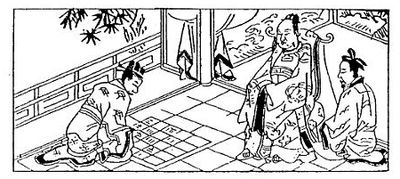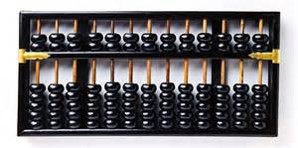By: Tao Steven Zheng (郑涛)
Power of the abacus[]
There is a growing epidemic of dyscalculia among today’s youth. The over-reliance of electronic calculators has led many to add and subtract slowly, forget their multiplication table, and fail to search for divisible factors. The abacus is an ancient computation tool that can remedy this modern malaise. How? Well, the abacus is just a tool that speeds up computation, but the computation is still done by the human brain. It trains the brain to think faster and more strategically. It internalizes the decimal number system. It requires the user to memorize the multiplication table, and the factors of a given integer.
Abacuses have been invented by several cultures around the globe; at different times. Many early abacuses were counting boards where people performed computations by placing and moving pebbles around. However in this series, I will focus on the two main abacuses still use today: the Chinese suan pan, and the Japanese soroban.
The Suan Pan and the Soroban []
The suan pan or Chinese abacus contains two decks. The upper deck contains two beads in each column, while the lower deck contains five beads in each column. The frame of a Chinese abacus is usually made of wood, and bound by some metal plates for reinforcements on each corner. Bamboo rods are fitted throughout the abacus to secure the beads.
The term suan pan (Chinese abacus) existed since the Han dynasty over 2000 years ago. It is uncertain if early Chinese abacuses looked like the ones today. The Chinese abacuses that we see today were definitely used since the Song dynasty about 1000 years ago, and were commonplace by the Ming dynasty around 500 years ago. By the Ming dynasty, there were also suan pan designed with one bead on top, and five beads on the bottom.
Similar to the Chinese abacus the soroban, or Japanese abacus, also contains two decks. However, there is only one bead in the top deck per column, and four beads in the bottom deck per column. The shape of the soroban beads are typically diamond-shaped. Traditionally, the soroban is made of wood and bamboo, but it is now common to see plastic soroban in stores.
The soroban is derived from the Chinese abacus, and has greatly evolved in the late 19th and early 20th century. The original soroban was imported from Ming China over 500 years ago with one bead on top and five beads on the bottom. The shift to a purely base ten currency led to reducing the lower deck to only four beads (the Chinese were using a base sixteen currency). In the modern era, a reset button was introduced for convenience. Now let’s move onto the advantages of both abacuses.
What are the advantages of the Suan Pan?
- Simpler arithmetic algorithms when using the extra beads
- Capable of computing in base 16 (hexadecimal system)
- Capable of computing in base 2 (binary system)
- The suan pan is great for exposing kids to base 2 and base 16 in the information age
What are the advantages of the Soroban?
- The more compact design with smaller beads makes the soroban faster than the suan pan
- Many soroban comes with a mechanical reset button for swift clearing
- The common diamond-shaped beads are arguably more ergonomic
Benefits of the abacus []
Why learn the abacus? The abacus makes life easier with or without the actual abacus in hand. From a cognitive perspective the abacus enhances the understanding of the decimal place-value system, helps you master arithmetic effectively and efficiently, calculate strategically with greater speed and accuracy.
Children exposed to the abacus are given many advantages when learning school mathematics. They live with the decimal place-value system, and see how addition and subtraction are linked. This is very useful in a world that measures everything in base-ten, from weights to distances to currency. When learning how to multiply and divide numbers on the abacus, the user must memorize the multiplication table. The memorization of the decimal value of basic fractions is also mandatory. Manipulating the beads of an abacus takes time and deliberate practice to master. With enough practice, the proficient abacus user can move the beads and perform computations swiftly. For these reasons, the abacus improves memory, builds number sense, improve reflexes, and help children make estimates very well.





